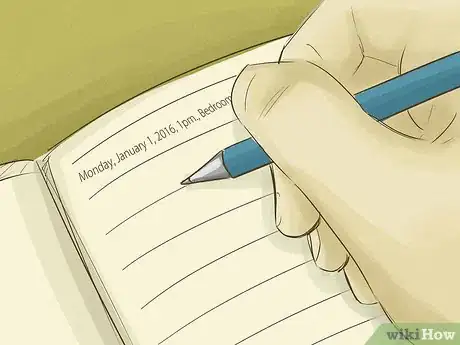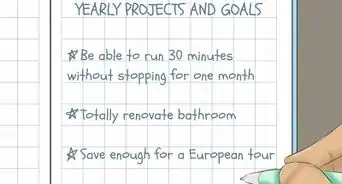This article was co-authored by Natalia S. David, PsyD and by wikiHow staff writer, Jennifer Mueller, JD. Dr. David is an Assistant Professor in Psychology at the University of Texas Southwestern Medical Center and a Psychiatry Consultant at Clements University Hospital and at Zale Lipshy University Hospital. She is a member of the Board of Behavioral Sleep Medicine, the Academy for Integrative Pain Management, and the American Psychological Association’s Division of Health Psychology. In 2017, she received the Baylor Scott & White Research Institute’s Podium Presentation Award and scholarship. She received her PsyD from Alliant International University in 2017 with an emphasis in Health Psychology.
There are 11 references cited in this article, which can be found at the bottom of the page.
This article has been viewed 43,219 times.
If you have a change you want to make in your life, or something you want to accomplish, a goal journal can be a good way to do that. Goal journals allow you to keep track of your progress, as well as keep you accountable for your progress. You don't need any special items or skills to keep a goal journal – just a little self-discipline. Update your journal every day and review your entries regularly to see how far you've come.[1]
Steps
Setting Up Your Journal
-
1Choose where you'll write. Pick a notebook, a computer file, or whatever else you want to use for your goal journal. Make sure it's something you feel comfortable writing in and that you can have available to you when you need it.
- There are a number of companies that make journals specifically designed to be used as goal journals. Use one of these if you find the formatting works for you.
- There also are apps designed for goal tracking and journaling. One of these might work for you, and you would have the benefit of having it on your smartphone so it would be convenient. For example, you might try GoalsOnTrack or Coach.me. Both of these apps are free on iOS and Android phones, and both have journaling features.[2]
-
2Write down your goals. Take some time to think about what you want to accomplish in your life and where you want to be. During this brainstorming session, don't judge or censor what you put down – include everything that comes to mind.[3]
- Visualize and separate your short term and long term goals. Short term goals are things you’d like to do within 6 months to a year, while you’ll aim to accomplish long term goals in 5-10 years. Write down what you see, who you'd like to be, and what you'd like to be doing.
Advertisement -
3Draw out your goals if you’re a visual learner. Sketch out pictures, make graphs, or create a visual game or flow chart to track your progress. Draw or even doodle pictures of your goals or the rewards you’ve set up for yourself along the way.
-
4Think up SMART goals. SMART stands for Specific, Measurable, Achievable, Results-focused, and Time-bound. These goals should be clear, realistic, set within a timeframe, and able to be tangibly measured. These parameters are often used by professional motivators when they’re coaching students. When you come up with a possible goal, ask yourself:[4]
- how you can make it more specific
- how you can measure whether you’ve achieved the goal
- whether the goal is possible to reach
- what is the purpose or benefit of accomplishing the goal
- when you want to have reached the goal by
-
5Prioritize and categorize your goals. Once you have a good list of goals, make a list of categories such as career, education, diet, exercise, and social life. Put your goals into the right categories and decide which ones you want to tackle first.
- For example, you may have a goal to work as a computer programmer, but you have to learn coding languages or get a degree first. Therefore, you should prioritize the education goal over the career goal.
- Try some simple, easy goals first. An early success will motivate you to keep going.
-
6Create a schedule. Once you've decided which goal you want to work on, break it down into smaller steps that you can achieve in a shorter period of time. These steps should be action-oriented and measurable.
- For example, if your goal is to get more exercise, you might set a goal of exercising 3 times a week. One step could be trying out different kinds of exercise, like jogging, weight-lifting, or swimming, to see what works best. Another could be figuring out what days work best for you and where you’ll work out (at home, at a gym, etc).
-
7Format your entries depending on your goals. How you organize your daily entries in your goal journal will depend to some extent on what your ultimate goal is, but ultimately, your entries should be scannable. You want to be able to look at each page and see your progress at a glance.
- For example, if your goal is to lose weight, you might have sections for your weight, foods you ate, and exercise you did that day. In a paper notebook, leave a large area for notes and reflections on your progress.
- If you're creating a physical goal journal using a paper notebook, you might want to use different colored markers or pens for different parts so they pop out. Use larger or bolder headings for each section.
Updating Your Journal
-
1Write every day. Establishing a habit of writing in your goal journal every day helps you anchor yourself and your commitment to the goal. The act of writing every day will help you track and measure your progress over time.[5]
- Journal about both progress and setbacks. You’ll be able to reflect on your actions and figure out what is working and what isn’t. Based on your reflections and conclusions, you can even adjust your goals.
-
2Journal at a specific time each day. To make everyday journaling a habit, set aside five to ten minutes at a time of day when you'll always be able to write in your journal. Typically it's easiest to journal in the morning after you wake up, or at night before you go to bed.[6]
- Journal in the evening if you have a goal that requires a lot of detail you're unlikely to remember the next day.
- Keep your journal in a place where it will be handy at the time you've chosen to write in it, such as on your bedside table.
-
3Be specific in your entries. You've set measurable goals, and whatever things you're measuring need a place in each entry you make in your goal journal. Keeping entries as specific as possible allows you to better track your progress over time.[7]
- For example, suppose you've decided to quit smoking. Record in your goal journal exactly how many cigarettes you smoke each day. Include additional details about where and when you smoked, and if you were with people or alone.
- Details can help you uncover patterns and identify hurdles that stand in the way of you achieving your goal.
-
4Reschedule goals as needed. Despite your best intentions, you may find that your daily or weekly steps toward your goal aren't realistic. Don't beat yourself up over this, just make your steps smaller.
- If you find that you're not meeting your daily or weekly goals more often than you are, it may be time to reassess. Look at the reasons you failed to achieve what you wanted to, and adjust accordingly.
- For example, suppose you're trying to cut calories. You find that on weekends you typically overindulge and consume more calories than you're supposed to. You may want to give yourself a "cheat day" when you can consume more calories, and take those calories out of other days when you have no problem meeting your goal.
-
5Learn from your failures. If you're struggling to make progress towards your goal, or if you keep back-sliding, look at it as a learning opportunity. Figure out where the problem lies and take steps to eliminate that problem so you can return to your goal.[8]
- For example, if your goal is to quit smoking, you may have noticed that you always end up smoking when you go out to a particular bar with your friends. This problem may be resolved by doing another activity with those friends, or moving your bar outing to a smoke-free location.
Getting the Most out of Your Journal
-
1Review your entries regularly. It's not enough to write in your goal journal every day. While the act of writing itself has benefits, you also need to read over those entries on a regular basis if you want to track your progress.[9]
- By going back over your entries, you may be able to identify patterns in your behavior that you didn't notice before. You can see how your work towards this goal is impacting other areas of your life.
- Set aside additional time at the end of each week to go through your entries for that week – just a couple of minutes is all it should take. Then at the end of each month, read over all of your entries for that month. You may want to leave extra space in your journal for thoughts or reflections on your progress at the end of each month.
-
2Update and rewrite illegible entries. You want your goal journal to exist as a permanent record of your progress towards your goal. As you're reviewing your entries, clean up any mistakes and clarify sloppy writing.
- You may want to do your initial journaling in a notebook, then copy your entries once a week into a clean computer file. The act of copying your entries also will help you review them and notice patterns emerging in your behavior.
-
3Protect your privacy by locking away your journal. Your goal journal may include discussions of sensitive situations, or reveal intimate details about your life. Keep your goal journal safe from prying eyes by hiding it in a secret location or in a locked drawer.[10]
- You need to be able to be 100 percent open and honest in your goal journal. You may be less inclined to do that if you are afraid someone else will be able to read it.
- If you're keeping your journal on your computer, you may want to password protect or encrypt the file so that anyone who accesses your computer won't be able to look at the document.
-
4Keep your journals indefinitely. Your goal journal is a record of your progress towards your goal. Even after you've achieved your goal, the journal has information that can help you if you decide to go after a different goal.[11]
- Looking back over your accomplishments also can be motivating. If you have a goal you achieved, you can read back through your goal journal when you're feeling a little down to remind yourself of how far you've come.
- If you're keeping a notebook as your journal, you may want to make a computer file each month, or once you've achieved your goal, to keep as a permanent record. You can either scan the pages or retype them from the words you wrote.
Daily Journal Entry Template
References
- ↑ https://www.usa.edu/blog/ways-journaling-benefits-students/
- ↑ https://libguides.stonehill.edu/c.php?g=555915&p=3844785
- ↑ https://inside.ewu.edu/calelearning/psychological-skills/goal-setting/
- ↑ https://www.ucop.edu/local-human-resources/_files/performance-appraisal/How%20to%20write%20SMART%20Goals%20v2.pdf
- ↑ https://psychcentral.com/blog/ready-set-journal-64-journaling-prompts-for-self-discovery
- ↑ https://www.helpguide.org/articles/stress/stress-management.htm
- ↑ https://positivepsychology.com/goal-setting/
- ↑ https://services.unimelb.edu.au/counsel/resources/study-related-issues/coping-with-failure
- ↑ https://www.apa.org/news/press/releases/2015/10/progress-goals










































































